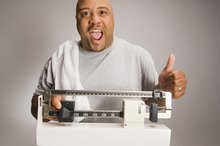Diet & Exercises for Men to Build Muscle & Lose Stomach Fat
The basics of muscle gain and fat remain the same, regardless of your gender. To become lean, you need to strength train and follow a healthy diet. As a man, you do have an advantage over most women, as it is likely you have greater muscle mass and so you will gain muscle more easily than women, because of your higher testosterone levels. Follow a diet geared toward lean muscle gain and exercises designed to torch fat and build muscle, and you'll get the fit physique you're looking for.
Adjust Your Calorie Intake for Bulking
Even though you're trying to shed belly fat, you should have a slight caloric surplus, meaning you eat more than you need to maintain weight, to allow for muscle growth. If you're currently maintaining your weight, increase your calorie intake by 250 calories to gain a half-pound per week.
If you're not sure how many calories you need to maintain weight and, therefore, how many calories you should eat to gain weight, use an online calculator to get a rough estimate. For example, a 30-year-old man who is 5-foot-9-inches tall, weighs 165 pounds and is active for an hour or more a day needs about 3,550 calories daily to maintain weight. To gain weight, he should eat about 3,800 calories daily.
While it might be tempting to pack in additional calories to gain weight quickly, resist that urge. If you gain weight too fast, you'll only put on extra fat and you won't get the lean look you want.
- Even though you're trying to shed belly fat, you should have a slight caloric surplus, meaning you eat more than you need to maintain weight, to allow for muscle growth.
- If you're currently maintaining your weight, increase your calorie intake by 250 calories to gain a half-pound per week.
Diet for a "Clean Bulk"
The Best P90X Workouts for Weight Loss
Learn More
Complete the rest of your diet with carbs and fat. Get about one fourth of your calories from fat, recommends Muscle & Fitness 2. For example, in a sample 3,800 calorie diet, you'd include 105 grams of fat, primarily from healthy sources such as:
- olive oil
- avocado
- seeds
- nuts
- fatty fish
The rest of your calories should come from carbs such as whole grains. Carbohydrates fuel your muscles and supply energy, so you'll be able to keep up with a demanding workout schedule.
- Complete the rest of your diet with carbs and fat.
- For example, in a sample 3,800 calorie diet, you'd include 105 grams of fat, primarily from healthy sources such as: * olive oil
* avocado
* seeds
* nuts
* fatty fish The rest of your calories should come from carbs such as whole grains.
Build Muscle With Strength Training Exercises
Building muscle requires strength training; with each workout, you'll challenge your muscles and cause microscopic tears within your muscle tissue, so it will grow back bigger and stronger. You'll get the greatest muscle-building benefits performing 6 to 12 repetitions of each exercise, choosing a weight that feels extremely difficult for the last 2 to 3 reps in each set. Perform exercises for your upper body, such as rows, pull-ups and pushups, as well as squats and dead lifts to build muscle in your lower body. Include abdominal exercises like side planks and wood chops.
Use resistance training to tone your abs and flatten your stomach. Make planks a regular part of your workout. Start by using your body weight, then increase the intensity by asking your spotter to place barbell plates on your back for additional resistance. Consider rounding out your routine with a yoga class -- many yoga poses challenge and strengthen your abdominals, and yoga also helps improve your posture so you'll look healthier and more confident.
- Building muscle requires strength training; with each workout, you'll challenge your muscles and cause microscopic tears within your muscle tissue, so it will grow back bigger and stronger.
- Consider rounding out your routine with a yoga class -- many yoga poses challenge and strengthen your abdominals, and yoga also helps improve your posture so you'll look healthier and more confident.
Burn Belly Fat With Cardio
The Best Diet Plan for Men Over 50
Learn More
Most of your focus in the gym should be on gaining muscle, but a few short bursts of cardio weekly can burn fat to help you look lean, not to mention the benefits it provides for your cardiovascular health. If you're relatively new to aerobic exercise, add two or three 20-minute aerobic workouts to your weekly schedule, and work at a moderate pace so you don't wear yourself out.
As your fitness increases, begin to incorporate intervals into your workout. For example, after warming up, you could work at maximum intensity for 10 seconds, then recover at a slower pace for 50 seconds. Repeat this sequence 10 times for a short-but-sweet workout. Intervals burn fat more efficiently than moderate cardio, and they also trigger excess post-exercise oxygen consumption, or EPOC, which keeps you burning fat after your workout.
- Most of your focus in the gym should be on gaining muscle, but a few short bursts of cardio weekly can burn fat to help you look lean, not to mention the benefits it provides for your cardiovascular health.
- If you're relatively new to aerobic exercise, add two or three 20-minute aerobic workouts to your weekly schedule, and work at a moderate pace so you don't wear yourself out.
Consider a Cutting Cycle for Stomach Fat
Adding more activity to your routine and building muscle mass increases your metabolism and calorie burn throughout the day, so you'll begin to lose the fat in your midsection naturally. After you develop your muscle mass to what you want it to be -- but you still have a little too much fat in your stomach -- consider a brief cutting cycle to burn excess fat.
To do that, you'll need to reduce your caloric intake. Use an online calculator to re-estimate your daily calorie burn. Likely, that will have changed since you started your fitness journey, so subtract 500 calories daily to get your new target. Maintain your target protein intake of 1 gram per pound of weight, but reduce your carb and fat intake so that you're meeting your new calorie goal. Keep your regular strength-training program, but add intervals to your cardio workouts, if you aren't already -- and if you are -- try to add one or two additional intervals for a slightly longer workout. You'll lose about a pound a week and, as long as you keep strength training and eating enough protein, you'll retain the muscle you need to get a lean physique.
- Adding more activity to your routine and building muscle mass increases your metabolism and calorie burn throughout the day, so you'll begin to lose the fat in your midsection naturally.
Related Articles
References
- Muscle & Fitness: Add Muscle, Subtract Fat: The Clean Bulk That Works
- Muscle & Fitness: Getting Big vs. Getting Strong
- University of New Mexico: HIIT vs. Continuous Endurance Training: Battle of the Aerobic Titans
- Baylor College of Medicine: Adult Energy Needs Calculator
- buffguy900
- BurningHeart
- thebarbarianway
Writer Bio
Sylvie Tremblay holds a Master of Science in molecular and cellular biology and has years of experience as a cancer researcher and neuroscientist. Based in Ontario, Canada, Tremblay is an experienced journalist and blogger specializing in nutrition, fitness, lifestyle, health and biotechnology, as well as real estate, agriculture and clean tech.








